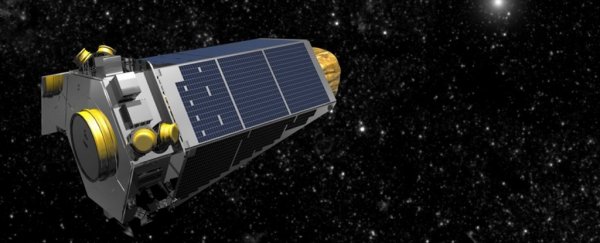Since its deployment in March of 2009, the Kepler space telescope has been a boon for exoplanet-hunters. As of March 8th, 2018, a total of 3,743 exoplanets have been confirmed, 2,649 of which were discovered by Kepler alone.
At the same time, the telescope has suffered its share of technical challenges. These include the failure of two reaction wheels, which severely hampered the telescope's ability to conduct its original mission.
Nevertheless, the Kepler team was able to return the telescope to a stable configuration by using small amounts of thruster fuel to compensate for the failed reaction wheels.
Unfortunately, after almost four years conducting its K2 observation campaign, the Kepler telescope is now running out fuel. Based on its remaining fuel and rate of consumption, NASA estimates that the telescope's mission will end in a few months.
For years, the Kepler space telescope has been locating planets around distant stars using the Transit Method (aka Transit Photometry).
This consists of monitors stars for periodic dips in brightness, which are caused by a planet passing in front of the star (i.e. transiting). Of all the methods used to hunt for exoplanets, the Transit Method is considered the most reliable, accounting for a total of 2,900 discoveries.
Naturally, this news comes as a disappointment to astronomers and exoplanet enthusiasts. But before anyone starts lamenting the situation, they should keep some things in mind.
For one, the Kepler mission has managed to last longer than anyone expected. Ever since the K2 campaign began, the telescope has been required to shift its field of view about every three months to conduct a new observation campaign.
Based on their original estimates, the Kepler team believed they had enough fuel to conduct 10 more campaigns. However, the mission has already completed 16 campaigns and the team just began their 17th.
As Charlie Sobeck, a system engineer for the Kepler space telescope mission, explained in a recent NASA press statement:
"Our current estimates are that Kepler's tank will run dry within several months – but we've been surprised by its performance before! So, while we anticipate flight operations ending soon, we are prepared to continue as long as the fuel allows."
"The Kepler team is planning to collect as much science data as possible in its remaining time and beam it back to Earth before the loss of the fuel-powered thrusters means that we can't aim the spacecraft for data transfer. We even have plans to take some final calibration data with the last bit of fuel, if the opportunity presents itself."
So while the mission is due to end soon, the science team hopes to gather as much scientific data as possible and beam it back to Earth before then.
They also hope to gather some final calibration data using the telescope's last bit of fuel, should the opportunity present itself. And since they cannot refuel the spacecraft, they hope to stop collecting data so they can use their last bit of fuel to point the spacecraft back towards Earth and bring it home.
"Without a gas gauge, we have been monitoring the spacecraft for warning signs of low fuel - such as a drop in the fuel tank's pressure and changes in the performance of the thrusters," said Sobeck.
"But in the end, we only have an estimate - not precise knowledge. Taking these measurements helps us decide how long we can comfortably keep collecting scientific data."
This has been standard practice for many NASA missions, where enough fuel has been reserved to conduct one last maneuver.
For example, the Cassini mission had to reserve fuel in order to descend into Saturn's atmosphere so it would avoid colliding with one of its moons and contaminating a potentially life-bearing environment.
Satellites also regularly conduct final maneuvers to ensure they don't crash into other satellites or fall to Earth.
While deep-space missions like Kepler are in no danger of crashing to Earth or contaminating a sensitive environment, this final maneuver is designed to ensure that the science team can squeeze every last drop of data from the spacecraft.
So before the mission wraps up, we can expect that this venerated planet-hunter will have some final surprises for us!
In the coming years, next-generation telescopes will be taking to space to pick up where Kepler and other space telescopes left off. These include the Transiting Exoplanet Survey Satellite (TESS), which will be conducting Transit surveys shortly after it launches in April of 2018.
By 2019, the James Webb Space Telescope (JWST) will also take to space and use its powerful infrared instruments to aid in the hunt for exoplanets.
So while we will soon be saying goodbye to the Kepler mission, its legacy will live on. In truth, the days of exoplanet discovery are just getting started!
Stay tuned for updates from the Kepler and K2 Science Center.
This article was originally published by Universe Today. Read the original article.
